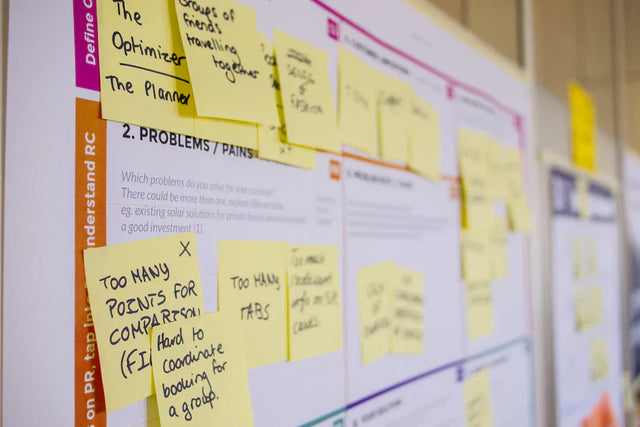Los comentarios de los clientes impulsan la innovación de productos y experiencias excepcionales
Frequently Asked Questions
1. Why is customer feedback important for businesses?
2. What are some effective methods for gathering customer feedback?
3. How can businesses implement customer feedback effectively?
4. Can you provide an example of how a brand has used customer feedback?
5. How can businesses create a feedback loop with their customers?
In today's dynamic market landscape, consumer preferences change rapidly, making it vital for businesses to adapt effectively. One of the best ways to stay ahead of the game is by incorporating customer feedback into your planning process. This approach not only helps you tailor your offerings to meet customer expectations but also fosters a strong sense of connection between your brand and its audience. In this blog post, we will delve into the importance of customer feedback, the different methods for gathering it, and how you can effectively implement this feedback with proven examples, including enhancing iconic products like the Fearless Ambition Hoodie from Avodah Dynamics.
The Importance of Customer Feedback
Customer feedback can illuminate various aspects of your business and offer invaluable insights. Understanding how your customers perceive your brand, services, and products is crucial for planning and enhancing customer satisfaction. Here are some reasons why customer feedback plays a significant role in your planning process:
Improves Product Development
Feedback gives your team direction when innovating or refining products. By understanding customers' likes and dislikes, you can streamline your design process, resulting in offerings that resonate more with your target audience.
Enhances Customer Experience
Incorporating feedback into your plan helps create products or services tailored to customer needs, thereby enhancing their overall experience. For a brand like Avodah Dynamics, ensuring that the customer experience around products like the Fearless Ambition Hoodie is in tune with what consumers seek will drive success.
Strengthens Customer Relationships
Engaging with customers shows that you value their opinions, which builds trust and loyalty. This trust can translate into repeat purchases and referrals, ultimately benefiting your bottom line.
Methods for Gathering Customer Feedback
There are numerous approaches to gather customer feedback, each suitable for different types of products and customer bases. Here are some effective methods you can consider:
Surveys and Questionnaires
One of the most common ways to gather customer feedback is through surveys. They can be distributed via email, social media, or directly on your website. Questions can range from satisfaction scales to open-ended questions about customer preferences regarding products, including things like the Fearless Ambition Hoodie. Tools like Google Forms or SurveyMonkey can make this process seamless.
Customer Interviews
Conducting in-depth interviews allows for a more personal touch. You can ask customers detailed questions about their experiences and expectations. This method provides rich qualitative data that can be incredibly useful when planning changes in your business strategy.
Social Media Monitoring
With the prevalence of social media, keeping an eye on mentions of your brand can provide real-time feedback. Platforms like Twitter and Instagram offer insights into customer sentiment. Engage with followers who express concerns or praise your products to gather actionable insights.
Online Reviews and Testimonials
Encouraging and analyzing online reviews can be beneficial for understanding what customers appreciate about your products and what areas require improvement. Encourage reviews on your Shopify store or associated platforms to gather feedback about items like the Fearless Ambition Hoodie.
Implementing Customer Feedback
Once you've gathered customer feedback, it's essential to analyze and implement it effectively. Here’s how to turn that information into actionable changes in your planning process:
Analyze the Data
Before you make any major decisions, take the time to analyze the feedback you've received. Look for patterns and trends that emerge from your survey results or social media monitoring. Are there consistent complaints about sizing in the Fearless Ambition Hoodie? Do customers mention they'd like to see more color options? Ensure you validate the data before drawing any conclusions.
Prioritize Feedback
Not all feedback is created equal. Some suggestions may require immediate attention, while others might need longer-term planning. Establish a prioritization system to ensure that the most pressing issues are addressed first without losing sight of smaller but significant suggestions.
Communicate Changes
When you make changes based on feedback, communicate those improvements to your customers. This could be through email newsletters, social media posts, or blog updates. Letting your customers know that you've listened and made changes can enhance their connection with your brand and increase loyalty.
Continuous Improvement
The integration of customer feedback should be an ongoing effort. Make it a part of your company's culture to ask for, listen to, and implement feedback regularly. Regularly scheduled surveys can help you stay in touch with what your customers are thinking long after the initial product launch.
Real-life Examples
To further solidify the importance of incorporating customer feedback, let’s look at a few examples of how brands successfully leveraged customer insights to drive their planning processes:
Case Study: Fashion Brands
Many fashion brands, such as Avodah Dynamics, successfully utilize customer feedback to evolve their product lines. For instance, a fashion company that produces hoodies might notice a growing demand for sustainable materials. By pivoting their production methods in response to this feedback, they not only meet consumer expectations but also differentiate themselves in a competitive market.
Case Study: Food and Beverage Industry
A popular coffee chain once received feedback from customers who wanted healthier options. They introduced a line of healthy smoothies. The sales from these new items exceeded expectations and diversified their offerings, showcasing firsthand how feedback can translate into strong business growth.
Creating a Feedback Loop
To facilitate and improve the feedback collection process, consider establishing a feedback loop within your communications strategy. Here's how:
1. Encourage Ongoing Input
Just like interacting on social media, encourage customers to provide feedback continuously. Use incentives like discounts or loyalty points to motivate customers to share their thoughts.
2. Update Customers Regularly
Keep your audience in the loop about any changes made based on their feedback. This can be through blog updates or newsletters, thus demonstrating that you value their input.
3. Train Your Team
Ensure that everyone on your team understands the significance of feedback. Training them to engage with customers effectively can maximize your insights and improve overall customer interaction.
Unlock the Full Potential of Your Brand
Incorporating customer feedback into your planning process is not just an option; it’s a necessity. By actively gathering, analyzing, and implementing customer insights, you will foster deeper relationships, enhance your products, and drive your overall business success. Brands like Avodah Dynamics that focus on listening to their customers can expect to see remarkable growth and customer loyalty over time. Adapt and evolve, and you'll be well on your way to securing a dominant position in your market. Embrace the power of your customers today, and watch your brand's future flourish!





0 Comentarios
No hay comentarios todavía. Sé el primero en comentar.